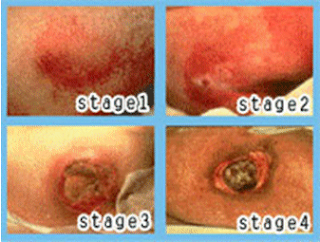Nursing Diagnosis for Decubitus Ulcer - 7 Nanda
Decubitus ulcer: A bed sore, a skin ulcer that comes from lying in one position too long so that the circulation in the skin is compromised by the pressure, particularly over a bony prominence such as the sacrum (sacral decubitus).
The root cause of which is always pressure on a point of the body which isn't relieved, this causes an ulcer to develop. Bed sores are most prevalent on the bed bound or immobile as they cannot move their body to prevent these sores appearing.
If a patient is bed-ridden or immobile, proper monitoring is essential to prevent bed sores from becoming a real problem. The staff in hospitals, care homes etc. must make sure they are constantly vigilant of the signs that an decubitus ulcer is starting to form and try and relieve the pressure on the patient. This can be done by moving the patient into another comfortable position thus relieving the pressure on the part of the body.
The pressure on the skin must be reduced by turning the patient in bed every 2 hours and by the use of a pressure-reducing mattress. Pressure-reducing mattresses include low–air loss beds, air-fluidized beds, and Roho cushion mattress seats for wheelchairs. Furthermore, sitting patients should shift their body weight every 15 minutes.
A pressure ulcer starts as reddened skin that gets worse over time. It forms a blister, then an open sore, and finally a crater.
The most common places for pressure ulcers to form are over bones close to the skin, like the elbow, heels, hips, ankles, shoulders, back, and back of the head.
Pressure sores are categorized by how severe they are, from Stage I (earliest signs) to Stage IV (worst):
- Stage I: A reddened area on the skin that, when pressed, does not turn white. This indicates that a pressure ulcer is starting to develop.
- Stage II: The skin blisters or forms an open sore. The area around the sore may be red and irritated.
- Stage III: The skin breakdown now looks like a crater. There is damage to the tissue below the skin.
- Stage IV: The pressure ulcer has become so deep that there is damage to the muscle and bone, and sometimes to tendons and joints.
7 Nursing Diagnosis for Decubitus Ulcer
1. Impaired Skin Integrity
related to:
mechanical damage of tissue secondary to stress,
shearing and friction.
2. Acute Pain
related to:
skin trauma,
infections of the skin
wound care.
3. Risk for Infection
related to:
display of decubitus ulcers to feces / urine drainage
personal hygiene is lacking.
4. Imbalanced Nutrition, Less Than Body Requirements
related to:
anorexia insufficiency secondary to oral input.
5. Impaired Physical Mobility
related to:
restriction of movement required,
status that is not conditioned,
loss of motor control or change in mental status.
6. Ineffective Individual Coping
related to:
chronic wounds,
changes in body image.
7. Disturbed Body Image
related to:
loss of skin layers.
ads

0 komentar: